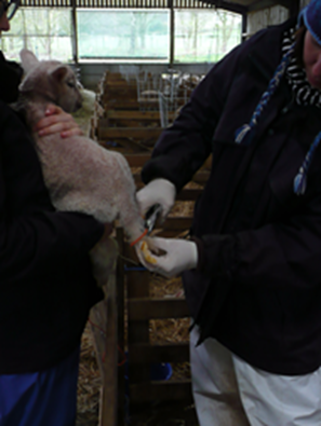Castration and tail docking of lambs are commonly performed management procedures in sheep farming. These interventions aim to prevent unwanted pregnancies caused by young rams that reach puberty, and to minimise risk of blowfly strike and maggot infestation of the breech, respectively. However, the procedures themselves cause pain and hence reduce sheep welfare.
Welfare could be improved by moving to less painful methods of castration and tail-docking, or by a consideration if the management goals could be achieved without the use of the procedures at all. Future effort to reduce reliance on castration and tail docking will require that the effectiveness of policy or management changes that support/encourage alternative management approaches can be tracked. This short scoping study, which is supporting and underpinned by work within the Strategic Research Programme, explored whether data currently exist within industry that would allow benchmarking of current use of castration and tail docking, and the methods employed.
Young lamb (Credit: SRUC)

Stage
Directory of Expertise
Purpose
Castration and tail docking have been commonly performed management procedures in UK sheep flocks for many years. It is believed that these procedures are more common in Scottish flocks than elsewhere in the UK as animals grow more slowly on upland and hill grazing, increasing the risk of lambs reaching puberty and unwanted pregnancies occurring before slaughter.
Tail-docking is carried out to prevent flystrike where blowfly maggots infest the wool and cause painful lesions. However, ongoing reliance on methods of castration and tail docking without pain relief itself impacts animal welfare.


Rubber ring tail docking (left) and castration with elastrator (right) (Credit: SRUC)
A recent Animal Welfare Committee Opinion on the Implications of Castration and Tail Docking for the Welfare of Lambs recommended limiting use of castration and tail docking to high-risk situations and requiring greater use of anaesthesia and analgesia.
.jpg)
Abnormal lying after rubber ring (RR) castration (Credit: SRUC)
Quantifying future changes in practice within industry requires that data exist to benchmark current practice and to track future trends. Our aim was to establish whether data are currently collected by industry bodies operating within the Scottish lamb sector on:
(a) the use of castration and tail docking and
(b) the methods employed to perform these procedures.
Results
We interviewed representatives from 16 organisations from across the lamb supply chain in Scotland. These organisations represented farm assurance, agricultural consultancy, veterinary practice and flock health planning, markets, livestock buyers, processing, abattoir inspection and retail.
Two themes were explored with each stakeholder:
(a) whether data are collected routinely or on occasion on the number of lambs castrated or tail docked;
(b) if so, whether the data collected allow the method of castration or tail docking to be determined.
Currently none of the stakeholder organisations routinely collect and store data on the use of castration or tail docking, except for one large abattoir, which provided evidence either directly or via Official Veterinarian feedback to Food Standards Scotland. This abattoir collects data on tail docking in the lairage but not on castration.
Some retailers collect data on use of castration and tail docking from a small minority of farmers who are members of specialist producer groups. These farmers are almost exclusively in England and Wales. Specialist producer groups may not be representative of practice in the broader industry.
The option of storing and collating data on farm practice during assurance scheme farm inspections (e.g. for the QMS Cattle and Sheep Assurance Scheme) should be explored as a potentially efficient and dynamic way to capture data on castration and tail docking and the methods used.
Benefits
The study has shown that specific effort will be required to capture data on current and future castration and tail docking practices. This will be required to monitor the impact of future policy developments regarding castration or tail docking. In Scotland, collection of data on industry practice may be most efficiently achieved by directly asking farmers about practices during assurance scheme inspections, although this would require discussion with those operating the schemes. This approach is likely to be necessary to collate data on the method of castration and tail docking and use of anaesthesia or analgesia.
Stakeholders indicated that assessment of animals or carcasses in abattoirs may be feasible if the financial costs of doing so were adequately offset, but assessment at this point may not accurately determine the method used for castration and tail docking.
This short study indicates that there will be a time and financial commitment to the collation of data to benchmark current industry reliance on castration and tail docking. However, such data will be necessary to monitor whether future policy interventions designed to reduce reliance on these procedures, or to promote less painful alternatives to current methods, have the intended benefit for animal welfare.
Project Partners
SRUC